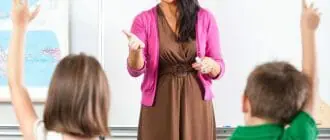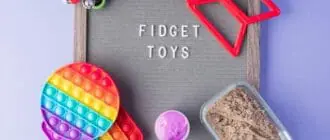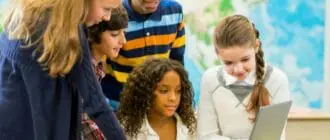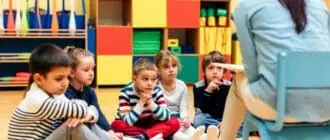Setting up a preschool classroom can be overwhelming when you are new to early education. Depending upon your classroom size, location, features, and the number of students in your class, there are a variety of considerations to make before the students arrive.
But then…
Preschool and early childhood education programs are usually optional, however, many youngsters will attend a formal type of preschool whether it be public, private, or home preschool before entering kindergarten at 5 years of age.
So, if you are expecting a new group of four-year-olds, many of whom have never attended school before, and they will be showing up at your classroom door bright-eyed and bushy-tailed, start by following these preschool classroom setup ideas to ensure a successful start for all!
Large Furniture

I always begin classroom setup by positioning large furniture in functional spaces around the room. Small preschool classroom setup can be even more challenging, so strategic furniture placement is even more critical for not only functionality but also for safety and visibility.
The most important factor to consider for preschool room arrangement is visibility. As a teacher, it is imperative that you always have open lines of visibility within your learning areas. Place large bookcases flush against the wall and anchor them with brackets and screws for safety.
If you plan on using a kidney table or teacher’s table, position it off to one side facing inwards so you can view the entire classroom from your seat. Ideally, if you have a paraprofessional or assistant teacher, you can position two teacher tables on opposite sides of the classroom.
Technology
If you do have technology availability such as computers, you may want to place them on a narrow child height table or counter along a wall near outlets for charging. This also keeps them out of the way allowing for more open space in the classroom.
If you have a whiteboard, Smartboard, or significant focal feature, be sure to place a large area rug below for the students to gather. Many teachers like to place a stool or rocking chair here for reading time, sharing circles, and other group presentations.
Student Seating
Having a few small tables- circular, square, or hexagon works fine for creating learning centers for your students to work when seated at a table.
Many times this is also where students will sit for mealtime, so it is important that the student chairs and table be stable and height-appropriate for preschoolers.
Students at this age do not need a desk, however, cubbies or baskets work well for storing individual student supplies. Keep bins or cubbies, clearly labeled with the children’s names and photograph neatly organized on low shelving or easy-to-reach bookcases.
Students probably need to keep a blanket in their cubby for nap time, as well as a jacket and a spare change of clothing for emergencies. All other school supplies should be kept out of reach from the children, and only provided when directly instructed by the classroom teachers.
Educational Resources
Preschool room setup ideas also include utilizing visuals. Academic visuals, such as charts and posters, should be placed around the room where students will be able to see them. Young children need to be taught how to refer back to them on a regular basis for effectiveness.
For instance, if most of your whole-group instruction will take place while students are seated at the rug, you should place an alphabet strip and number line about the front whiteboard or along the front wall. Make notes in your lesson plan to refer to these resources regularly.
A teaching calendar, posters of colors, shapes, numbers, and letters should be displayed and utilized during daily lessons. Posting classroom rules are also necessary. These rules and procedures should be simple, age-appropriate, and child-friendly.
Organizing School Supplies

Of course, you will need crayons, scissors, glue, and the like, but it would not be wise to have these items easily accessible to students for safety reasons. I like to color-code my classroom tables and use matching plastic caddies for the storage of supplies for each table and center.
For example, if you have 4 students per table, you can establish pre-stocked bins with four scissors, four glue sticks, and four boxes of crayons to place at the center of the table when needed for activities. Simply collect and remove the material baskets when not in use.
Manipulatives refer to small toys and learning tools such as blocks, puzzles, counters, shapes, linking chains, play money, and more. These are typically used with the classroom teacher or during centers.
Place each of your manipulatives into large clear plastic bins so you can see through the bins quickly to find what you are looking for. Then, tape a colored image of the item, a photograph of the actual blocks for instance, on the shelf where the blocks should be returned after use.
You can organize all toys, bins, manipulatives, supplies, and cubbies by using photographs and labels so the students can learn how to put things back in their proper place on the shelf after centers. These tricks will help you determine how to set up a preschool classroom much easier!
Labels
Labeling also keeps things tidy and easier to find!
You can label almost everything, just be sure to use large, student-friendly font choices. I like to label items such as flag, clock, sink, bathroom, door, window, calendar, and so on.
Pretend Play
Imaginary play is critical for the development of preschool learners because so much of their learning is acquired through play. Creating stations or interactive work centers is highly important in any preschool or kindergarten classroom.
Keep all materials needed for play in each clearly labeled learning center.
For example, easels with paint, paintbrushes, and smocks are positioned in the art center. The housekeeping center usually includes a pretend kitchen and dining area, dress-up clothing, career-related or otherwise, pots and pans, and other household play items.
You can choose to rotate students through each of these learning centers daily or on a schedule. A building center may incorporate blocks, legos, or magnetic tiles. Children at this age enjoy playing on the floor, so placing a soft rug designated for “building” is perfectly fine.
I have also seen teachers use hula hoops, tape on the floor, and small rugs for keeping students in designated centers during playtime. Just make sure all stations are visible from your position in the classroom and located in areas that allow for movement and creativity.
A cozy reading center with a variety of trade books, pillows, and beanbag chairs is not only meaningful for pre-reading development but also provides a calming area for overwhelmed students to take a mental break if needed.
Learn more about the benefits of pretend play for pre-schoolers here:
Classroom Restrooms
If you are lucky enough to have student restrooms available in your classroom make sure to create a visual so that students know where the door is located if it is for boys and/or girls, and how to know if the bathroom is occupied.
Can students reach the sink in your classroom? You may need to place a step stool for the students to use. Be sure students have access to soap and paper towels as well.
Check out the handwashing timer on our list of top-reviewed classroom timers! Position this bad boy near your sink to ensure students are washing their hands for the appropriate amount of time.
Frequently Asked Questions
1. What should be in a preschool classroom?
When you enter any early childhood classroom you hope to see an orderly, bright, and clean learning space.
Remember that preschool children can become overwhelmed easily, so it is important to keep additional clutter to a minimum. Over-stimulation in early childhood can lead to meltdowns and an inability to focus.
2. How do you structure a preschool classroom?
Aside from large furniture placement and small materials organized and stored in easy-to-access areas of the classroom, it is important to think about how the students will be expected to move around within their learning environment or between centers.
You can place student photos on their seats (chairs and the floor) using clear packaging tape so students know exactly where to sit. Many educators also like to place stickers or numbers in an evenly spaced line on the floor to show students where to stand while lining up to exit.
Final Considerations
There are many preschool room setup ideas available for educators today. Once you are familiar with your classroom space and resources, you can get started on your preschool room setup. Be sure to factor in the number of teachers and students who will be using the space.
Take a look at other schools where you can walk through and observe preschool classroom design ideas first-hand. Observing an early childhood classroom in action would provide even further insight into how students interact throughout and move throughout the space.
Just remember to get creative and by establishing your classroom as a positive learning environment, you and your students will be off to a great start!
Last Updated on July 24, 2022 by Emily
- Facebook9
- Twitter21
- Pinterest67
- 97shares




